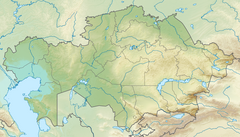
Back نهر إمبا Arabic نهر امبا (نهر فى اوبليس اكتوبى) ARZ Emba çayı Azerbaijani Емба (река) Bulgarian Zhem CEB Emba (řeka) Czech Эмба CV Emba German Río Emba Spanish Žem Estonian
| Emba | |
|---|---|
 | |
| Location | |
| Country | Kazakhstan |
| Physical characteristics | |
| Mouth | Caspian Sea |
• coordinates | 46°37′42″N 53°19′02″E / 46.62833°N 53.31722°E |
| Length | 712 km (442 mi) |
| Basin size | 40,400 km2 (15,600 sq mi) |
The Emba (Kazakh: Ембі Embı or Жем Jem, Russian: Эмба) in west Kazakhstan rises in the Mugodzhar Hills and flows across the Sub-Ural Plateau and Caspian Depression into the Caspian Sea. It is 712 kilometres (442 mi) long, and has a drainage basin of 40,400 square kilometres (15,600 sq mi).[1] It flows through the north of the Ust-Urt plateau, and reaches the Caspian by a series of shallow lagoons, which were navigable in the 18th century. The lower course traverses an area of salt domes and the petroleum-rich Emba fields. It is sometimes regarded as a definition for the natural boundary between Europe and Asia.
In its upper course, the Emba is a small river, its valley barely over 2,000 metres (6,600 ft) wide. Lower down, after the waters of the Temir River flow into it, the Emba's valleys widen to almost 7 kilometres (4 mi). The Emba flows in a single channel, only breaking off into little arms in places. But around 100 kilometres (62 mi) before it enters the Caspian Sea, it breaks off in places to form several lakes, which are connected to each other through slender channels that only run during flooding. The Emba is a snow-fed river. It freezes over in winter, a process that begins in November and lasts until March.[2]
- ^ Эмба (река), Great Soviet Encyclopedia
- ^ Zonn, Igor S.; et al. (2010-05-26). The Caspian Sea Encyclopedia. Springer. ISBN 9783642115240. Retrieved 26 July 2013.
